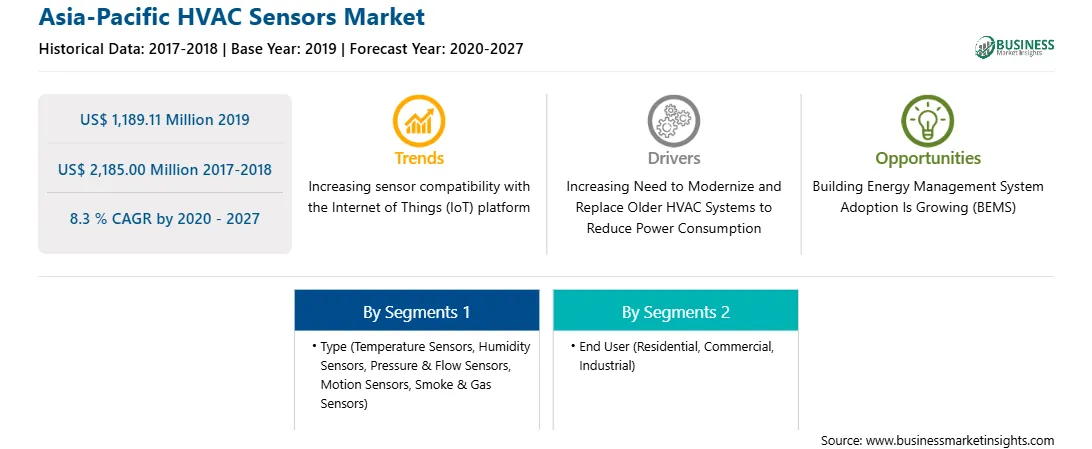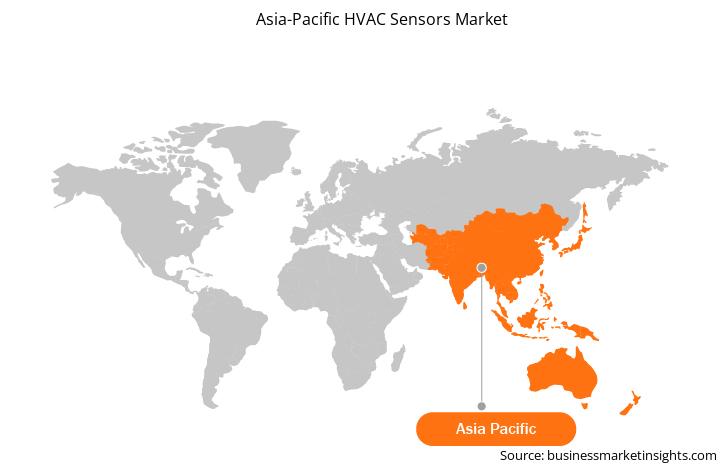亚太地区 HVAC 传感器市场预测至 2027 年 - COVID-19 影响和区域分析(按类型(温度传感器、湿度传感器、压力和流量传感器、运动传感器、烟雾和气体传感器等)和最终用户(住宅、商业、和工业)
No. of Pages: 150 | Report Code: TIPRE00020050 | Category: Electronics and Semiconductor
No. of Pages: 150 | Report Code: TIPRE00020050 | Category: Electronics and Semiconductor
发展中国家(尤其是印度和中国)可支配收入的增加为部署 HVAC 传感器带来了庞大的客户群空调、通风和供暖系统,这正在推动该地区 HVAC 传感器市场的增长。中国是暖通空调传感器的领先制造中心,而印度和日本也被认为是该区域市场增长的重要贡献者。亚太地区各个国家的特点是大规模生产住宅、商业和工业应用所需的 HVAC 传感器。由于拥有熟练的人力资源,印度和中国的制造公司数量不断增加,正在推动暖通空调传感器市场的增长。此外,商业领域暖通空调系统销量的增加和暖通空调传感器的进步支持了市场的增长。此外,三菱电机公司和江森自控日立空调等领先的暖通空调传感器制造公司的存在正在促进市场增长。例如,2019年10月,江森自控日立空调公司在印度投资2250万美元,建立一个新的全球开发制造中心,用于生产商业和住宅领域的暖通空调系统。市场参与者的这种发展正在推动市场的增长。此外,智慧城市的蓬勃发展以及智能、互联、节能的物联网暖通空调系统的兴起是推动亚太地区暖通空调传感器市场增长的主要因素。
此外, 亚太地区暖通空调传感器市场预计将从2019年的11.8911亿美元增长到2027年的21.850亿美元;预计 2020 年至 2027 年复合年增长率为 8.3%。建筑行业的升级预计将推动亚太地区 HVAC 传感器市场的蓬勃发展。亚太地区发展中经济体的建筑业正在经历巨大增长,对商业建筑以及火车站、汽车站、机场和教育机构等基础设施和机构发展进行了大量投资。建筑业的快速增长归因于不断增长的城市人口对更高生活水平的要求。此外,购物中心、娱乐中心、电影院和办公楼等商业建筑的兴起也推动了暖通空调系统的安装。此外,其中一些经济体还计划通过为外国投资者提供有利的商业环境和支持当地工业来促进其工业部门的发展。 “中国制造2025”和“印度制造”是各国政府支持工业化的举措之一。此外,一些外国企业正在将其制造设施迁移到亚太地区的低成本经济体,预计这将推动工业建设。由于 HVAC 系统是施工过程中不可或缺的系统之一,因此 HVAC 系统的部署可能会随着施工的不断增加而增加,从而推动亚太地区 HVAC 传感器市场。市场概况和动态
主要市场细分市场
从类型来看,温度传感器细分市场在2019年亚太地区暖通空调传感器市场中占据最大份额。从最终用户来看,商业细分市场占据了2019 年亚太地区暖通空调传感器市场的市场份额更大。
准备本亚太地区暖通空调传感器市场报告时参考的一些主要一手和二手来源包括公司网站、年度报告、财务报告、国家政府文件和统计数据库等。报告中列出的主要公司有BELIMO AIRCONTROLS (USA), INC.;艾默生电气公司;霍尼韦尔国际公司;江森自控公司;施耐德电气;森马蒂克公司;森萨塔科技公司;盛思锐股份公司;西门子公司; TE Connectivity Ltd.
Strategic insights for Asia-Pacific HVAC Sensors involve closely monitoring industry trends, consumer behaviours, and competitor actions to identify opportunities for growth. By leveraging data analytics, businesses can anticipate market shifts and make informed decisions that align with evolving customer needs. Understanding these dynamics helps companies adjust their strategies proactively, enhance customer engagement, and strengthen their competitive edge. Building strong relationships with stakeholders and staying agile in response to changes ensures long-term success in any market.

| Report Attribute | Details |
|---|---|
| Market size in 2019 | US$ 1,189.11 Million |
| Market Size by 2027 | US$ 2,185.00 Million |
| Global CAGR (2020 - 2027) | 8.3 % |
| Historical Data | 2017-2018 |
| Forecast period | 2020-2027 |
| Segments Covered |
By 类型
|
| Regions and Countries Covered | 亚太地区
|
| Market leaders and key company profiles |
The regional scope of Asia-Pacific HVAC Sensors refers to the geographical area in which a business operates and competes. Understanding regional nuances, such as local consumer preferences, economic conditions, and regulatory environments, is crucial for tailoring strategies to specific markets. Businesses can expand their reach by identifying underserved regions or adapting their offerings to meet regional demands. A clear regional focus allows for more effective resource allocation, targeted marketing, and better positioning against local competitors, ultimately driving growth in those specific areas.

The Asia-Pacific HVAC Sensors Market is valued at US$ 1,189.11 Million in 2019, it is projected to reach US$ 2,185.00 Million by 2027.
As per our report Asia-Pacific HVAC Sensors Market, the market size is valued at US$ 1,189.11 Million in 2019, projecting it to reach US$ 2,185.00 Million by 2027. This translates to a CAGR of approximately 8.3 % during the forecast period.
The Asia-Pacific HVAC Sensors Market report typically cover these key segments-
The historic period, base year, and forecast period can vary slightly depending on the specific market research report. However, for the Asia-Pacific HVAC Sensors Market report:
The Asia-Pacific HVAC Sensors Market is populated by several key players, each contributing to its growth and innovation. Some of the major players include:
The Asia-Pacific HVAC Sensors Market report is valuable for diverse stakeholders, including:
Essentially, anyone involved in or considering involvement in the Asia-Pacific HVAC Sensors Market value chain can benefit from the information contained in a comprehensive market report.